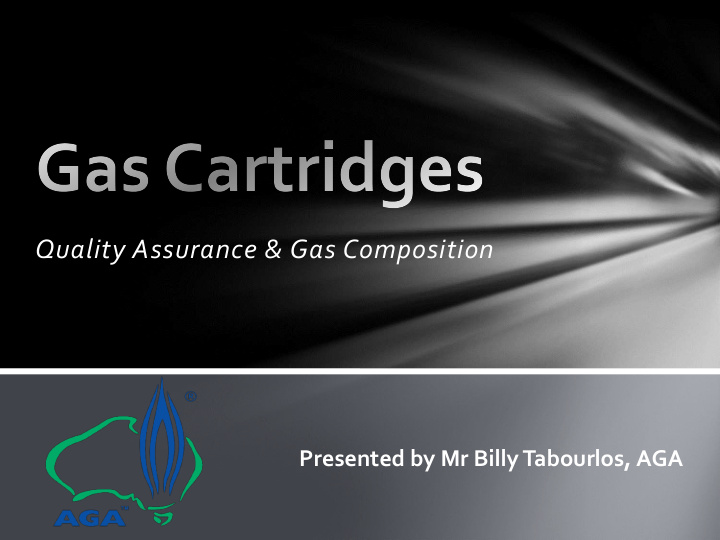



Quality Assurance & Gas Composition Presented by Mr Billy Tabourlos, AGA
• Background • Energy • Why the injuries and fatalities? • What are we doing about it? • AGA Certification • Safety Devices • Future Work
• Gas Cartridges come in different shapes and sizes 220g, 435g, 450g, short fat, tall skinny • Different connections and sealing means Re-sealable valve, screw type, pierceable • Mass produced in 100’s of millions
This presentation will focus on the 220g Butane cartridges
• In the Australian market to date, most 220g cartridges come from Korea, but are also manufactured in many other countries • Differences in design criteria and quality assurance protocols • They are shipped, transported and stored with gas in them, usually >95% Butane • Usually sold full in packs of 4 or 6 • Predominately used with camping and leisure products
Standards • EN 417 • UL 147B • KGS AC211 • JIA F 006 • DOT 39 • … • AS 2030 (Not a design Standard) • AS 2278 (Aerosol Standard)
Gas Composition • Gas compositions vary • Predominately Butane (either I-Butane or N-Butane) • Some Propane – higher vapour pressure
Composition • Random selection from the Australian market
• Butane contains ~50MJ/kg of energy • ~ 12 MJ of energy in a 220g cartridge • Equivalent to 2.6kg of TNT • 1 MJ = 1,000,000 J • LPG expands ~270 times the volume from liquid phase to gaseous phase
• Accelerate a 1 tonne car from 0 – 100km/h ~ 0.4 MJ (30 times less energy)
• Running for 1 hour ~ 3 MJ (4 times less energy)
• AGA Experiment (explosion without ignition)
• AGA Experiment (explosion with ignition)
Number of gas product recalls since 2006 12 11 Number of gas appliance Product Recalls in Australia 10 9 8 7 6 5 4 3 2 1 0 2006 2007 2008 2009 2010 2011 2012 2013 2014 2015 2016 Year
• Incidents involving fires and explosions of gas cartridge cookers escalated over the last few years • Fatalities and serious injuries • Rely heavily on the quality and design of the appliances
• Do not have a safety device of their own • Rupture pressure at ~1.5MPa compared to a refillable cylinder at ~10MPa
• The nozzle dimensions are critical to ensure safe sealing with appliances • Standards may vary around the world • Some Standards do not include dimensions • May not be compatible with appliances
• Improving cartridge cooker requirements • Extreme temperature hazard test • Two independent shut off devices • Etc. • Improving the quality assurance of gas cartridges
• Liaised with the world leaders in cartridge manufacturing • Shared information with leading notified and testing bodies globally • Liaised with government regulators in Australia and internationally • Developed the AGA Certification Scheme and Standard
What does the Scheme encompass? • Factory Inspections Inspection and testing requirements along the production line • Type Testing Laboratory testing by independent AGA Authorised Laboratories
• Post Certification Surveillance On-site
• Random market surveillance & Laboratory Testing
Cartridge Standard AGA 301 covers: • Dimensions • Gas composition • Pressure testing • Drop Testing • Durability Testing • Leakage Testing • Vibration Testing • Material Testing • Connection nozzle tests
Manufacturers developed safety devices • CRV • RVR • PRV • Shut-off
CRV (Countersink release vent) and RVR • Releases gas in a controlled manner before rupture occurs • Prevents an explosion • Gives enough time for the operator to react and clear the area
PRV (Pressure relief valve) • Relieves the pressure in the cartridge before the deformation pressure is reached. • Re-seats when pressure drops to allowable limit
Shut off • Shuts the gas off at a pre-determined pressure • Stops the flow of gas to the appliance
• Develop Standard for Safety Devices • Share information with leading international bodies such as JIA, KGS, CSA, BSI & TUV • Work closely with the manufacturers • Liaise with government bodies nationally and internationally
QUESTIONS
Recommend
More recommend